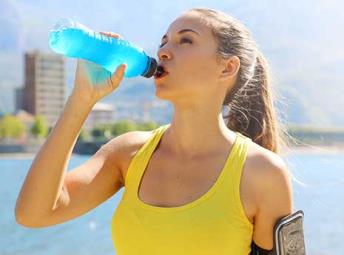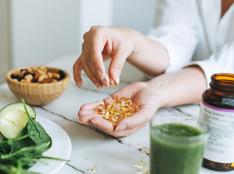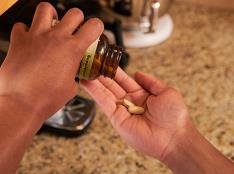
Sunlight is one of the most abundant sources of vitamin D (our bodies make the nutrient by absorbing UVB rays). Kastor, who's battled skin cancer, suspects her vigilant use of sunscreen contributed to her deficiency. And hers is not an unusual case. According to a March 2009 study in the Archives of Internal Medicine, more than three-quarters of adults are vitamin D deficient. "Runners aren't doing better than the average population," says Todd Whitthorne, who oversaw a 2008 study at the Cooper Clinic in Dallas that found that 75 percent of those averaging 20 miles a week have low vitamin D levels.
To help recharge muscles and aid performance, try these healthy drinks from Mother Nature.
Researchers have long known vitamin D is important for bone health and that a deficiency can lead to serious (if rare) bone diseases such as rickets. But new research points to broader health benefits of getting adequate D, including lower risk of cancer, diabetes, and heart disease — as D well as increased athletic performance. "With enough D," says John J. Cannell, M.D., president of the Vitamin D Council, "you'll run longer and faster, recover more quickly, and suffer fewer injuries."
Potential for Athletes
A number of new studies show vitamin D's vital effect on athletic performance. One study, published in February 2009 in The Journal of Clinical Endocrinology & Metabolism, concludes that adolescents with higher levels of vitamin D can jump higher, quicker, and with greater power than those with lower vitamin D levels. A review in Molecular Aspects of Medicine in December 2008 shows that vitamin D increases the size of fast-twitch muscles and muscular strength. Some research shows low levels of vitamin D may increase risk for sports injuries, including stress fractures such as Kastor's, because the nutrient is so vital for bone health.
Cannell recently published a literature review in Medicine & Science in Sports & Exercise examining the relationship between vitamin D, UVB exposure, and athletics. He looked at studies from the 1940s and 1950s on German and Russian athletes who received UVB radiation. Those studies suggest that exposure to UVB may boost performance. Other studies Cannell reviewed suggest physical performance peaks in the summer and then declines in early fall; one possible explanation for this link is that UVB is strongest in the summer season, contributing to better athletic performance that time of year.
Perform better and prevent injuries with this guide to stay healthy.
Are You Getting Enough?
There are almost no symptoms of vitamin D deficiency, so one of the only ways to know you're getting an adequate amount is with an expensive blood test. Runners who live in the northern half of the United States and all of Canada and Europe (where winter sun isn't strong enough to make vitamin D) are more at risk than others. People who use sunblock, spend a lot of time indoors, or have dark skin (more pigment works as a natural sunscreen) are also at risk of a deficiency.
Holick recommends getting between 200 and 400 IU of vitamin D every day through food. While there aren't a huge number of naturally high vitamin D sources, many foods—from mushrooms to cereal—are fortified with it (see "Eat Your Vitamins," below). Because even the richest food sources contain only a few hundred IU, runners should consider taking a daily vitamin D supplement that contains 2,000 IU, says Holick.
Eating the perfect diet of meat and veggies may be the key to running—and living—well.
Holick suggests getting moderate sun exposure, aiming for 10 to 15 minutes of sun two or three times weekly from May to October between late morning and mid afternoon when the sun is strongest. (He also advises protecting your hands and face with SPF, though, since they've likely sustained the most UVB damage.) During this time, you'll make 1,000 to 3,000 IU of vitamin D, which will stay in your body longer than D from food or supplements. "There's little evidence that moderate sun exposure increases skin-cancer risk," say Holick and other experts. Still, the American Academy of Dermatology, which recently acknowledged that sun protection can cause vitamin D deficiency, doesn't condone sun exposure as a way to boost the mineral. It recommends getting vitamin D from food and supplements.That's the route Kastor has chosen, making sure she gets an adequate amount of vitamin D by eating foods rich in the nutrient and taking a supplement. "Hopefully, others will learn from my experience," she says, "and not have to discover their deficiencies the same way I did."
Eat Better
Together, calcium and vitamin D protect your bones. To get 1,200 to 1,500 mg of calcium a day, eat plenty of dairy, dark greens, and canned fish.
Search for delicious and vitamin-rich dinner ideas with the Rodale recipe finder.
Eat Your Vitamins
Cod Liver Oil packs 450 IU of vitamin D per teaspoon — but tastes like, well, cod liver. Try getting your D from these tastier sources instead:
400 IU mushrooms enriched with vitamin D, 3 oz
360 IU salmon, 3.5 oz
345 IU mackerel, 3.5 oz
250 IU sardines, canned in oil, 1.75 oz
200 IU tuna, canned in oil, 3 oz
98 IU milk, Vitamin D- fortified 1 cup
60 IU margarine, fortified with D 1 tablespoon
40-50 IU cereal, fortified with 10 percent of vitamin D Daily Value 3/4 cup
20 IU whole egg
12 IU Swiss cheese, 1 oz








Discuss This Article